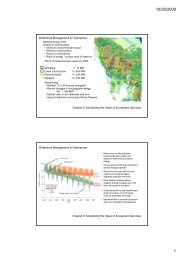RAINFOR GEM Intensive Plots Manual (pdf) - University of Oxford
RAINFOR GEM Intensive Plots Manual (pdf) - University of Oxford
RAINFOR GEM Intensive Plots Manual (pdf) - University of Oxford
- No tags were found...
Create successful ePaper yourself
Turn your PDF publications into a flip-book with our unique Google optimized e-Paper software.
Equipment: 25 litter traps per ha (one per subplot, designed as illustrated above), paper bags, tweezers, brushes,weighing balance (0.01 g resolution).Litter traps should be emptied every two weeks 84 to minimise decomposition between visits. Fine litter isdefined as all organic litter, but including only woody material less than 2 cm diameter 85 . Woody material over2 cm diameter which enters the traps should be removed and spread around the plot. Once the leaves for SLAcalculation have been removed, remaining fine litter should be removed into bags and dried at around 80°C toconstant mass as soon as possible to prevent decomposition (within 48 h 86 ). Once dried, litter should beseparated into (1) leaves (including petioles, rachises and petiolules), (2) woody material, (3) fruits, (4) flowers,(5) seeds 87 and (6) fine debris (unidentifiable particles that pass through a 2 mm mesh) (separate epiphytes, ifthey occur, but do not divide into parts), HOWEVER if there are insufficient staff or time then the litter may beleft unsorted at this point. Then, weigh (if separation takes more than a few minutes, re-dry in the oven andweigh immediately on removal) and place into appropriately named (site, plot, date, site, trap number, type <strong>of</strong>litter) paper bags for storage (old samples will need to be discarded regularly according to the availability <strong>of</strong>storage space). Dry weight <strong>of</strong> the litter should be noted in an appropriate datasheet.A critical consideration with litter separation is to calculate the amount <strong>of</strong> time available to separate alllitter before even more is collected, and modify the separation rate accordingly 88 . Otherwise, the rate <strong>of</strong> litterseparation may lag far behind litter collection, leading to accumulation <strong>of</strong> unprocessed samples and increasedrisks <strong>of</strong> sample loss and/or degradation.Specific Leaf Area (SLA)Equipment: Digital camera and tripod or scanner, transparent sheets (e.g. perspex, glass), ruler, drying oven,paper bags, weighing balance (0.01 g resolution).Every three months, leaves should be collected from the 12 evenly numbered litter fall traps (out <strong>of</strong> the 25 littertraps in total per ha) and stored in plastic bags to avoid desiccation. These are for calculating specific leaf area(SLA) and if possible should be immediately separated in the field whilst still wet (if not possible, bag them wetand sort back at the lab, keeping unsorted samples in a freezer). Images <strong>of</strong> the leaves should be taken, eitherwith a digital camera or scanner (the digital camera approach is more versatile in field situations, while imagescaptured with a scanner require much less time for image processing).84 If it is logistically impossible to maintain a regular schedule all year round, nominate regular periods <strong>of</strong> e.g. two weeks and at eachperiod visit and empty all traps at the beginning (discarding all trap contents) and then at the end (recording trap contents as describedabove). If litter fall is high at certain sites, it may also be necessary to visit and empty the traps outwith these periods to avoid meshbreakages.85 Slightly different from the 1 cm upper bound in Clark et al. (2001a).86 If this is logistically impossible, either keep refrigerated or air-dry the samples and oven-dry at first opportunity.87 Combine categories 3-5 into “reproductive parts” if it is unfeasible to separate them (e.g. crushed fruit containing many seeds).88 e.g. nominate a subset <strong>of</strong> traps to be separated each time and separate all traps every few months to ensure that spatial variability isstill being adequately sampled.67





